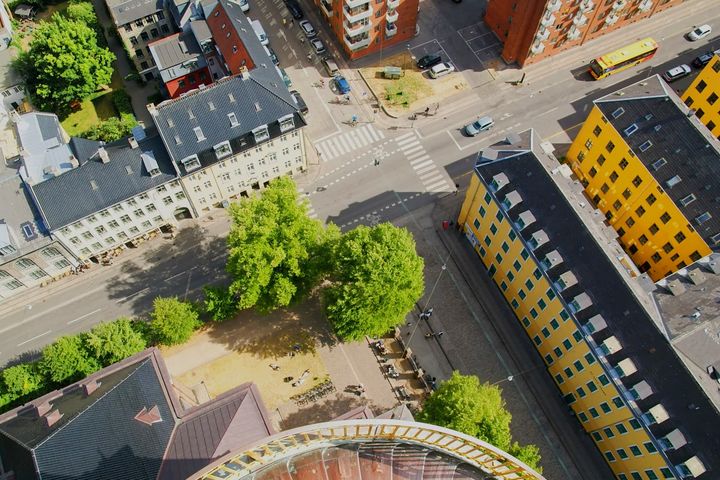New study finds hidden trees across Europe: A billion tons of biomass is overlooked today
Through satellite imaging a new AI driven mapping of biomass and CO2 storage from the University of Copenhagen shows that a huge number of trees are overlooked in Europe’s urban, rural, and agricultural areas. Across Europe, researchers have discovered a billion tons of hidden biomass.

Trees isolate carbon dioxide from the atmosphere, benefit wildlife, and biodiversity and make us humans happy. Perhaps you're lucky enough to have trees in your backyard, outside your window, or in a nearby park. Forests aren’t the only place where foliage enriches the planet. But until now, we have simply not been able to account for all the many trees not in forests, according to new research from the University of Copenhagen’s Department of Geosciences and Natural Resource Management.
Using an advanced algorithm that combines satellite imagery and artificial intelligence, researchers have been able to closely study Europe from above and examine how many trees there actually are beyond our forested areas. These trees are not currently counted in national forest inventories that typically does not include trees outside forests.
The survey shows 15 million hectares of tree coverage outside of forested areas across the continent as a whole. This corresponds to a billion tons of hidden biomass in urban and rural areas that are used for agriculture or other purposes that can now be included in various statistics and models.
"For example, there are a great many trees in holiday home areas and cities that aren’t included when national inventories of forest resources are compiled. Our study shows that there is hidden potential in relation to carbon storage beyond forests that ought to be included in climate models and biomass inventories," says Associate Professor Martin Brandt from the Department of Geosciences and Natural Resource Management.
Urban trees of the Netherlands
The Netherlands, UK, Ireland, and Denmark has the highest percentage of tree cover outside forest areas. The Netherlands takes first place with nearly twenty-five percent of the country's tree cover is outside forests, eight percent of which grows in cities.
In the UK, twenty-two per cent of the country's tree cover is outside forests, and for Ireland, the amount is just shy of twenty percent. For forest-rich countries, the proportion of tree cover outside forest areas is significantly smaller. For example, just under two percent of Finland's total tree cover is found outside the forests.
"In European countries with many large forested areas, trees outside forests don't make much of a difference. But in countries like Denmark, the Netherlands, the UK and Ireland, whose forest resources are not enormous, these trees play an important role in biodiversity, microclimate, habitats, landscape values, and hydrological cycles," says Martin Brandt.
Country statistics of tree cover and biomass:
| Country | Total tree cover (% of country) | Tree cover outside forests (% of total) | Total biomass in Tg | Tree biomass outside forests in Tg (% of total) |
| Ireland | 10.5% | 19.7% | 36.65 | 3.24 (8.8%) |
| United Kingdom | 14.1% | 22.1% | 264.29 | 26.29 (9.9%) |
| The Netherlands | 14.8% | 24.6% | 47.32 | 5.79 (12.2%) |
| Denmark | 16.9% | 19.5% | 63.47 | 4.74 (7.5%) |
| Ukraine | 20.1% | 11.4% | 1534.2 | 53.2 (3.5%) |
| France | 34.6% | 9.7% | 2388.2 | 77.2 (3.2%) |
| Germany | 36.1% | 10.0% | 2264.3 | 65.4 (2.9%) |
| Italy | 38.6% | 7.5% | 1501.3 | 37.6 (2.5%) |
| Estonia | 50.3% | 3.0% | 259.3 | 2.7 (1.0%) |
| Finland | 67.8% | 1.7% | 1726.2 | 9.76 (0.6%) |
AI counts trees with 92.4 percent accuracy
Using data from national inventories, among other things, that divides countries into urban, forest, and rural areas, the researchers designed a deep learning algorithm that can recognize trees down to three meters high from their tree crowns. The researchers fed the algorithm detailed satellite imagery of Europe as a whole, which was used to calculate the amount of tree cover outside of forested areas in each country.
“The quality of our AI’s results comes very close to that of satellite images, which are very expensive to produce in the scale investigated here. Our mapping of trees outside the forests has a precision of 92.4 percent," says PhD student Siyu Liu, who is first author on the study.
The latest study of Europe's hidden tree cover is one in a long series of studies conducted over the past few years that have shed light on tree cover in the Sahara and other parts of Africa, among other regions, using advanced technology using detailed satellite imagery and artificial intelligence.
Better forest monitoring
According to Martin Brandt, mappings with this level of precision and detail had never been possible. It marks an advance that will make it easier to monitor our forests and biomass in the future.
“Today, we send people out to conduct manual measurements of biomass. But in Denmark alone, there are more than 20,000 pieces of forested land. So, this is a massive task. Our method makes it possible to conduct more frequent and rapid monitoring, at a time where landscapes change rapidly, and the timely and accurate assessment of carbon stocks is most important," he concludes.
The basis for the work was Danish national forest inventory (NFI) data provided by senior scientist Thomas Nord-Larsen, who stresses the importance of field data:
“Without forest inventory data used to calibrate such methods, satellite observations are just digital numbers without meaning. These inventory data are however typically limited to forests, and methods such as presented here allow to scale inventory data to every corner of the country.”
About the study
The research has been published in the scientific journal Science Advances and was conducted by Siyu Liu, Martin Brandt, Thomas Nord-Larsen, Jerome Chave, Florian Reiner, Nico Lang, Xiaoye Tong, Phillipe Ciais, Christian Igel, Adrian Pascual, Juan Guerra-Hernandez, Sizhou Li, Maurice Mugabowindekwe, Sassan Saatchi, Yuemin Yue, Zhengchao Chen and Rasmus Fensholt.
The research was funded by the European Research Council (ERC) under the European Union’s Horizon 2020 research and innovation programme (grant agreement no. 947757 TOFDRY) and as part of the Forestplan project funded by the Danish Environmental Protection Agency
Contact
Martin Brandt
Associate Professor
Department of Geosciences and Natural Resource Management
University of Copenhagen
mabr@ign.ku.dk
+45 44 16 49 65
Thomas Nord-Larsen
Senior researcher
Department of Geosciences and Natural Resource Management
University of Copenhagen
tnl@ign.ku.dk
+45 40 32 43 94
Michael Skov Jensen
Journalist and team coordinator
The Faculty of Science
University of Copenhagen
msj@science.ku.dk
+ 45 93 56 58 97
Følg pressemeddelelser fra Københavns Universitet - Det Natur- og Biovidenskabelige Fakultet
Skriv dig op her, og modtag pressemeddelelser på e-mail. Indtast din e-mail, klik på abonner, og følg instruktionerne i den udsendte e-mail.
Flere pressemeddelelser fra Københavns Universitet - Det Natur- og Biovidenskabelige Fakultet
Saving the Asian Unicorn – If It Still Exists5.5.2025 17:00:00 CEST | Press release
The saola, an antelope-like bovine, is one of the world’s rarest and most endangered mammals. In fact, it hasn’t been observed in over 10 years. Researchers from the University of Copenhagen, in collaboration with Vietnamese scientists and an international team of researchers, have for the first time mapped the saola’s complete genome, and they have used that knowledge to estimate the chances of saving it – if it still exists.
Bakterier bruger gammelt krigstrick til at overliste vira: Kan hjælpe med at bekæmpe ’superbugs’30.4.2025 07:30:00 CEST | Pressemeddelelse
Forskere har opdaget en ny type immunforsvar i coli-bakterier, der vender en virusinfektion mod vira selv. Systemet er opkaldt efter den kinesiske militærstrateg Kongming som var berømt for at bruge fjendens våben til at besejre dem. Opdagelsen kan bruges i udviklingen af fremtidige bioteknologiske værktøjer og måske som et alternativ til antibiotika til at bekæmpe multiresistente bakterier.
Nyt forskeruddannelsesprogram skal udklække fremtidens kvantespecialister29.4.2025 10:24:11 CEST | Pressemeddelelse
Med støtte fra Villum Fonden opretter Københavns Universitet og DTU et nyt forskeruddannelsesprogram, der skal være med til at sikre, at Danmark kan bevare sin styrkeposition inden for kvanteforskning i fremtiden.
Ancient grain has huge climate potential and could play a key role in Europe’s future8.4.2025 11:41:23 CEST | Press release
Sorghum is one of the world’s oldest grains and possesses many traits that can benefit food security, climate resilience, and biodiversity. However, the mechanisms behind these traits have long remained a mystery to researchers, which has hindered efficient cultivation. Now, a new technique and a biobank - developed in collaboration with the University of Copenhagen - have made research and breeding possible at an unprecedented pace, paving the way to an effective crop in both the Global North and South.
Ældgammel kornsort har kæmpe klimapotentiale og kan blive vigtig i Europas fremtid8.4.2025 11:11:07 CEST | Pressemeddelelse
Sorghum er en af verden ældste kornsorter og har mange egenskaber, der kan gavne fødevaresikkerhed, klima og biodiversitet. Mekanismerne bag egenskaberne har dog været en gåde for forskerne, og det har stået i vejen for en effektiv dyrkning. Ny teknik og biobank, udviklet i et samarbejde med Københavns Universitet, åbner nu for forskning og forædling i turbogear. Det kan bane vej til en effektiv afgrøde i både det globale nord og syd.
I vores nyhedsrum kan du læse alle vores pressemeddelelser, tilgå materiale i form af billeder og dokumenter samt finde vores kontaktoplysninger.
Besøg vores nyhedsrum